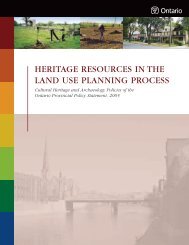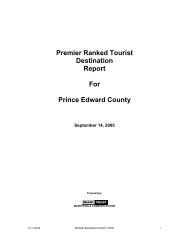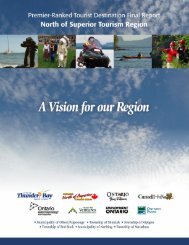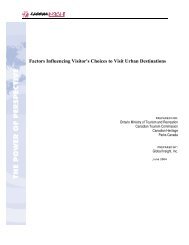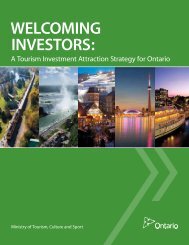<strong>Management</strong> <strong>Guidelines</strong> for <strong>For</strong>estry <strong>and</strong> <strong>Resource</strong>-<strong>Based</strong> <strong>Tourism</strong> – INTRODUCTION1.0 INTRODUCTIONThese <strong>Guidelines</strong> are intended to assist with planningforestry operations in those parts of Ontario’s forestbeing used for both forestry <strong>and</strong> tourism. The"<strong>Guidelines</strong>" will be of interest to members of forestmanagement planning teams who must prepare forestmanagement plans every five years; they will also be ofinterest to the tourist industry. The tourist industrymay find the useful information in the <strong>Guidelines</strong>when participating in forest management planning;opportunities to participate in planning are providedthrough the forest management planning process <strong>and</strong>,through the newly created opportunity to negotiate<strong>Resource</strong> Stewardship Agreements.Information in this Guide:1. Introduces the reader to forest managementplanning.2. Defines the general planning needs of the tourist<strong>and</strong> forest industries.3. Provides practical advice for those involved inplanning forestry operations in areas used by thetourist industry.4. Describes various tools <strong>and</strong> techniques forprotecting resource-based tourism values.5. Discusses the evaluation of the <strong>Guidelines</strong>’effectiveness.These <strong>Guidelines</strong> are one source of expert information.Readers are encouraged to use other sources ofinformation, especially that which can come from theindividual experience of those negotiating <strong>Resource</strong>Stewardship Agreements <strong>and</strong> developing forest managementplans.1.1 BackgroundPublic forests in Ontario are managed to produce avariety of benefits. The goal of forest management isto ensure the long-term health of forest ecosystems forthe benefit of local <strong>and</strong> global environments, whileenabling present <strong>and</strong> future generations to meet theirsocial <strong>and</strong> material needs.All forestry operations occurring within Ontario’s publicforests are directed by a forest management plan.The forest management plan must provide for thesustainability of the forest <strong>and</strong> have regard to the plantlife, animal life, water, soil, air, social <strong>and</strong> economicvalues. <strong>For</strong>est management plans are produced foreach forest management unit in Ontario; there aremore than 50 management units. Each forest managementplan must consider the needs of a diverse rangeof forest users including those of the resource-basedtourism industry. The process for developing the plansprovides various opportunities for public involvement.Those responsible for preparing forest managementplans must consult a wide range of planning manuals<strong>and</strong> guidelines including these <strong>Management</strong><strong>Guidelines</strong> for <strong>For</strong>estry <strong>and</strong> <strong>Resource</strong>-based <strong>Tourism</strong>.Timber <strong>Management</strong> <strong>Guidelines</strong> for the Protection of<strong>Tourism</strong> Values were first produced <strong>and</strong> distributed in1987. Much has changed since that time including:• A new legislative framework: the Crown <strong>For</strong>estSustainability Act (CFSA) 1994,• A new l<strong>and</strong> use strategy: Ontario’s Living Legacy(1999)• Ontario’s <strong>For</strong>est Accord: which enabled the creation ofan extensive parks <strong>and</strong> protected areas system whilealso considering the needs of the forest industry.• A <strong>Resource</strong>-based <strong>Tourism</strong> Policy (1997) which promotes<strong>and</strong> encourages the development of Ontario’sresource-based tourism industry in an ecologically<strong>and</strong> economically sustainable manner,• The <strong>Tourism</strong> <strong>and</strong> <strong>For</strong>estry Industry Memor<strong>and</strong>um ofUnderst<strong>and</strong>ing (2001) which sets out a process fornegotiating local resource stewardship agreements.These changes <strong>and</strong> other business <strong>and</strong> technologyrelatedchanges have resulted in a different approachto forest management on the ground. One of the significantchanges in the approach to forest managementplanning has been the willingness of both theresource-based tourism <strong>and</strong> forest industries to searchfor ways to address each others’ needs while workingin the same forest.1
<strong>Management</strong> <strong>Guidelines</strong> for <strong>For</strong>estry <strong>and</strong> <strong>Resource</strong>-<strong>Based</strong> <strong>Tourism</strong> – INTRODUCTIONThese guidelines summarise those managementoptions <strong>and</strong> practices to be considered when developingoperational prescriptions in forest managementplans intended to address resource-based tourisminterests or values. The guidelines can serve as a commonset of information for both the tourist <strong>and</strong> forestindustries as they work together to formulate plans forworking in the same forest.Nothing in these guidelines shall prejudice or affect inany way the treaty <strong>and</strong> aboriginal rights of aboriginalpeople in Ontario.1.2 Legislative framework<strong>For</strong>est management on crown l<strong>and</strong> is the responsibilityof the Minister of Natural <strong>Resource</strong>s through theCFSA. The Class Environmental Assessment for Timber<strong>Management</strong> on Crown L<strong>and</strong>s in Ontario was approvedin1994. Both of these pieces of legislation govern howforest management takes place on Crown l<strong>and</strong>. TheCFSA provides for the sustainability of crown forests<strong>and</strong> in accordance with that objective, to managecrown forests to meet social, economic <strong>and</strong> environmentalneeds of present <strong>and</strong> future generations.Under the CFSA there are four manuals, which furtherexplain how forest management is to take place.One of these is the <strong>For</strong>est <strong>Management</strong> PlanningManual (FMPM), 1996 which outlines the process <strong>and</strong>gives the format that must be followed in order for aforest management plan to be prepared <strong>and</strong> approved.These plans are prepared for every forest managementunit where forestry operations are to take place; theyare prepared every five years <strong>and</strong> consider the needs ofthe forest for the next 20 years.Another manual, the <strong>For</strong>est Operations <strong>and</strong> SilvicultureManual (1995) requires that these guidelines –<strong>Management</strong> <strong>Guidelines</strong> for <strong>For</strong>estry <strong>and</strong> <strong>Resource</strong>based<strong>Tourism</strong> 2001- as well as many others for otherforest values, be considered during the preparation <strong>and</strong>implementation of forest management plans.The class Environmental Assessment for Timber<strong>Management</strong> on Crown L<strong>and</strong>s in Ontario wasapproved in 1994 with the condition that <strong>Guidelines</strong><strong>and</strong> other implementation manuals be reviewed <strong>and</strong>revised as required.The other two manuals are the Scaling Manual <strong>and</strong>the <strong>For</strong>est Information Manual.All forestry operations, which are planned to addressresource-based tourism values, must follow the legaldirection set out in the CFSA.Licensing of resource-based tourism establishments isthe responsibility of the Minister of <strong>Tourism</strong> throughthe <strong>Tourism</strong> Act <strong>and</strong> Regulation 1037. This legislationprovides the legal basis for which resource-basedtourism businesses are eligible a resource stewardshipagreement (RSA).1.2.1 Application of the guidelinesThese guidelines are intended to provide assistance <strong>and</strong>direction to resource-based tourism <strong>and</strong> forest industryinterests when they are involved in forest managementplanning or the development, implementation, <strong>and</strong>maintenance of a RSA. Ontario’s Living Legacy, the<strong>Resource</strong>-<strong>Based</strong> <strong>Tourism</strong> Policy <strong>and</strong> the <strong>Tourism</strong> <strong>and</strong> <strong>For</strong>estryIndustry Memor<strong>and</strong>um of Underst<strong>and</strong>ing (MOU), <strong>and</strong> itsassociated Guide to resource Stewardship Agreements, areimportant documents for consideration when planningfor forestry <strong>and</strong> resource-based tourism.The guidelines may be considered when writingresource stewardship agreements <strong>and</strong> must be consideredwhen writing forest management plans when thedecision to conduct forest management operations mayaffect a resource-based tourism industry’s operations.The guidelines contain a variety of techniques <strong>and</strong> bestpractices that will help to operationalize forestry in afashion which addresses the tourist industries needs inthe forest. These, used alone or, in any combination,can contribute to the tourists’ perception of wilderness<strong>and</strong> remoteness. While, the guidelines, alone, cannotdeliver remoteness <strong>and</strong> wilderness since these are inpart, perceptually based values, which vary from oneindividual to another, they can assist in maintainingremoteness.These guidelines <strong>and</strong>, forest management plans, takedirection from Ontario’s Living Legacy <strong>and</strong> other l<strong>and</strong>use planning documents. L<strong>and</strong> use planning determineswhere forest management can take place; forest managementplanning, then, directs how forestry will takeplace on l<strong>and</strong>s selected for this purpose.2



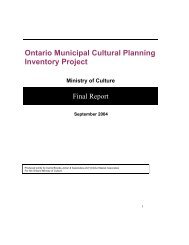
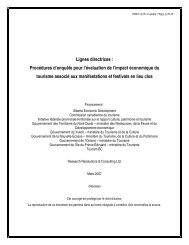
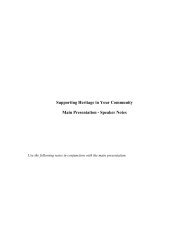
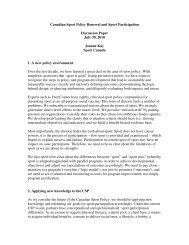
![THIS AGREEMENT made this [date], between [name of owner] (the ...](https://img.yumpu.com/49827605/1/158x260/this-agreement-made-this-date-between-name-of-owner-the-.jpg?quality=85)


